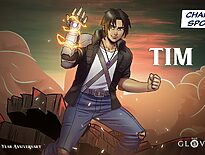Geek Native has been lucky enough to grab a sliver of Gareth Hanrahan’s time.

We took the chance to put three questions to him about Trail of Cthulhu, of which he is a co-writer, and about to go three times over its funding goal on BackerKit.
There’s still time to join the crowdfunder, but only a day or so.
We’ve also got an unhealthy amount of art from the dangerous RPG to threaten your understanding of reality.
How does the Trail of Cthulhu differ from Call of Cthulhu?
First, Trail’s built around the GUMSHOE system, which is designed from the ground up for investigative play. In GUMSHOE, you’ve got a bunch of investigative abilities that *always* work. If there’s a clue to be found, and you use the right ability in the right place, there’s no rolling, no chance of failure. You get the information. Sherlock Holmes doesn’t need to make a Spot Hidden roll to find the tell-tale footprint, and neither do you. The challenge of mystery-solving is putting the clues together to work out what’s going on and then deciding what to do about it.
Second, we go back to Sandy Petersen‘s original approach when it comes to describing the Cthulhu Mythos – the gods and titans of the Mythos are presented as contradictory, ambiguous mysteries. All the creatures, all the horrors are presented with lots of options and interpretations to make them freshly terrifying.
Third, it’s written by Ken Hite – Ken Suppressed Transmissions Hite, Ken Tour de Lovecraft Hite, and he’s one of the most erudite and experienced Cthulhu writers and game designers ever.
GUMSHOE ensures players get clues, but how do you balance that with player agency and meaningful choices?
Can I reject the premise of the question? “Players getting clues” doesn’t need to be balanced with “players having agency to make meaningful choices” – players having (some!) information on which to make their decisions is what makes them meaningful. GUMSHOE’s core idea is that it’s always more fun when the players get information; a good mystery isn’t the GM saying “you don’t find anything – ooooh, how mysterious it is to live in ignorance!!”, it’s the GM giving the players *lots* of information, a halo of seemingly disconnected or even contradictory clues that orbit around some central, terrible relevation, some insight that’ll tie everything together. The players have agency because they’re able to get clues and act on them.



How does the Trail of Cthulhu encourage roleplaying and character development, especially given the investigative focus?
There are lots of tools, rules and techniques in the game to encourage roleplaying. Every investigator has a Drive – a core aspect of their personality that compels them to investigate the Mythos. Maybe they’re driven by Remorse, or foolish Curiosity, or their Artistic Sensitivity leads them to seek out the weird. Or maybe it’s some Lovecraftian family curse In The Blood. Investigators also have a supporting cast – their Sources of Stability – and are encouraged to state their beliefs, their Pillars of Sanity (or, if you’re on the Gamemaster’s side of the screen, the philosophical pins to be knocked down with the bowling ball of Cthulhu).
Part of your investigative toolkit are Interpersonal Abilities, too – ways to persuade or convince witnesses to reveal what they know. You can integrate them into your roleplaying – and even spend points from them for added benefits. Want to play a gravel-voiced detective that strikes fear into criminals? Take the Intimidation ability, and spend a point to make them quake in their boots.
We also include several Campaign Frames, which comprise both reasons for the player characters to work together (“You’re all academics in Miskatonic! You’re all Chicago gangsters fighting a Mythos-empowered Al Capone!”) and suggestions for adventures and ongoing mysteries for the GM to build on.






Quick Links
- Backerkit: Trail of Cthulhu


